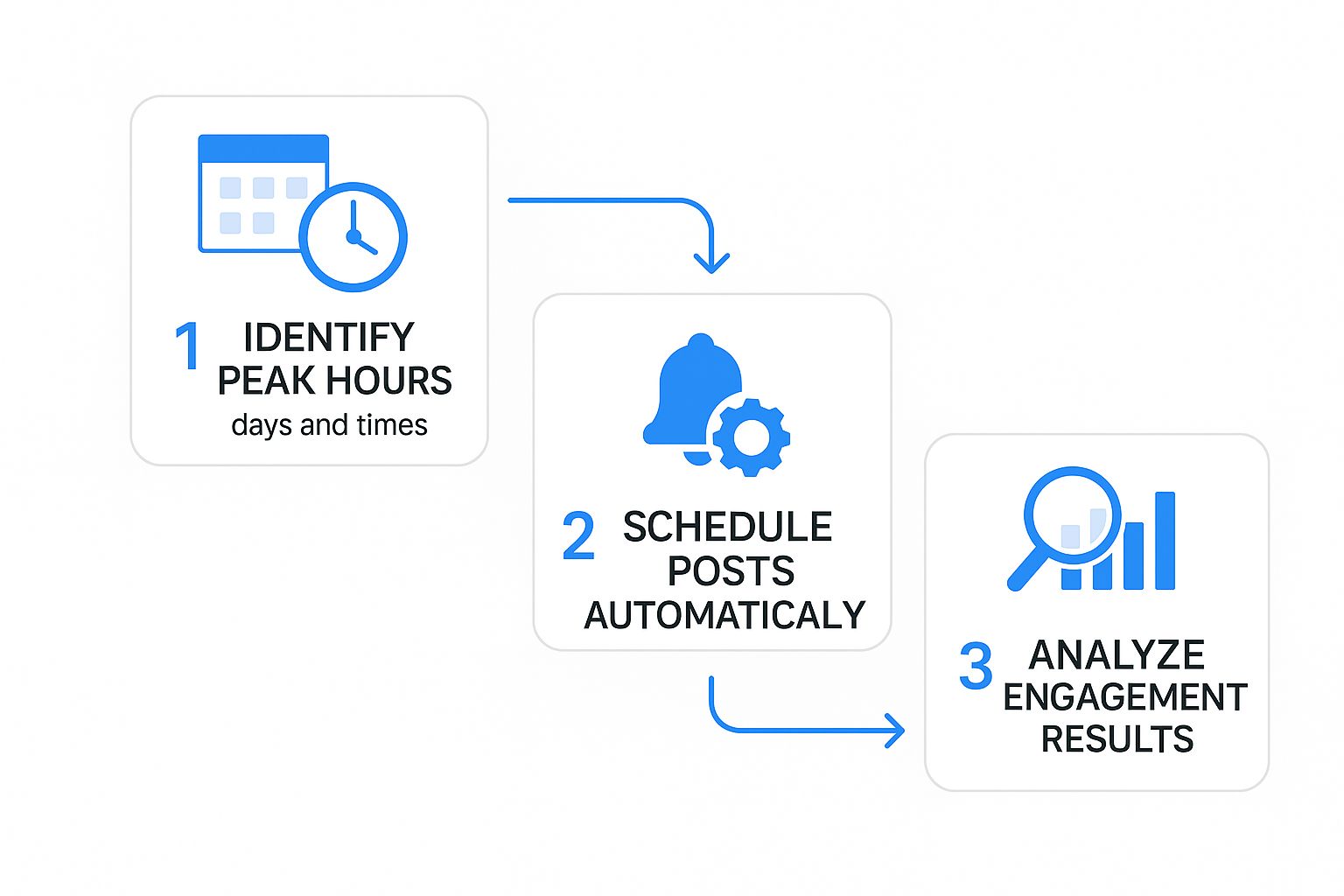If you want to maintain a high-impact presence on Twitter without being glued to your screen 24/7, setting up automatic posts is the answer. It’s a strategy that involves using smart tools to schedule your content ahead of time. This ensures your profile stays active and engaging, even when you’re busy with other parts of your business. Frankly, it’s how top creators and brands manage to scale their reach so effectively.
Why Smart Twitter Automation Is a Necessity
Let’s be real for a moment. Trying to manually post on Twitter every single day is a recipe for burnout. While the time-saving aspect of automation is a huge win, the real magic is in achieving strategic consistency. A well-planned system for automatic Twitter posts transforms you from a reactive content creator into a proactive strategist who's always one step ahead.
Think about it: a brand with a global audience can schedule posts to go live while their team is sound asleep, capturing engagement from every time zone. You never miss an opportunity to connect with your followers, wherever they are. This approach also keeps your brand voice steady and your message reinforced around the clock.
Beyond Just Saving Time
The power of automation goes way beyond just scheduling. It frees up your most valuable resource—your creative energy—for the high-impact tasks a machine simply can't do.
- Deeper Community Engagement: Instead of just broadcasting content, you can invest that reclaimed time in replying to comments, jumping into relevant conversations, and building real relationships.
- Strategic Planning: Automation gives you the breathing room to step back, analyze what’s actually working, brainstorm new content pillars, and fine-tune your entire social media game plan.
- Better Content Quality: You can batch-create and schedule amazing content when you're feeling inspired, rather than scrambling for something to post at the last minute. This is a core idea we explore in our guide on how to automate content creation without losing that human touch.
The sheer scale of Twitter (now X) makes this strategy non-negotiable. With roughly 611 million monthly active users spending billions of minutes on the platform daily, consistency is what gets you seen. Brands that automate effectively can meet the high posting frequency needed to cut through the noise. You can dive deeper into these Twitter statistics on SocialPilot.com.
Ultimately, smart automation isn't just about being more efficient. It's a foundational part of a strategy for scaling your impact and achieving sustainable growth on the platform.
Choosing Your Automation Style and Workflow

Before you even think about touching a tool, let's talk strategy. Putting your Twitter on autopilot isn't a one-size-fits-all deal. What works for a news blog will fall flat for a SaaS company. Your brand, your content, and your ultimate goals will steer you toward the right path.
I've found that the most effective automation strategies boil down to two main workflows. Figuring out which one—or which mix—is right for you is the first real step. This decision will shape the kind of content you make and how you schedule your automatic Twitter posts.
The Evergreen Engine Workflow
Think of this as your bedrock for consistency. The Evergreen Engine runs on a library of timeless, high-value content that stays relevant for months, or even years. It’s like a slow-burning fire, consistently warming up your audience without you having to add wood every single day. If your brand has a core message or a set of foundational principles, this is for you.
For example, a software company could build an amazing Evergreen Engine with content like:
- Quick tips showing off a specific product feature.
- Links to cornerstone blog posts or powerful case studies.
- Snippets of glowing customer testimonials or quotes from industry leaders.
You can set this content to cycle through your feed at different intervals, making sure new followers see your greatest hits and your timeline never goes silent.
The Topical Pulse Workflow
On the other end of the spectrum is the Topical Pulse. This is all about what’s happening right now. This workflow is perfect for brands that need to be part of the current conversation, whether it’s breaking news, industry trends, or viral moments. It requires you to be more hands-on, since you're creating and queuing content with a much shorter shelf life.
A marketing agency, for instance, might use this to comment on a new Google algorithm update. The post might be irrelevant in a week, but its immediate impact can be massive.
Pro Tip: The magic really happens when you blend both. I recommend using the Evergreen Engine for about 70% of your content to maintain a consistent presence. Then, layer in the Topical Pulse for the other 30% to add that timely, relevant spark. This creates a balanced feed that feels both dependable and completely current.
Building a Content Library That Feels Human

Let's be honest, the biggest worry with automation is sounding like a robot. A feed filled with lifeless, promotional automatic twitter posts is the fastest way to get unfollowed. The secret to getting it right isn't about the tool you use; it's about the fuel you give it. Your content library is everything.
A great library isn't just a folder of links and images. It's a carefully curated collection of content designed to deliver continuous value and start real conversations. The trick is to create multiple, distinct posts from a single piece of content, ensuring your feed never gets stale. Think about it: one blog post can easily become a dozen different tweets.
Crafting Engaging Post Variations
Simply dropping a link to your latest article and calling it a day won't cut it. You have to break down your core content into bite-sized, human-focused pieces. The goal is to build a library stocked with different angles that can be scheduled over time.
For any given article or idea, try creating posts like these:
- Direct Quotes: Pull out the most powerful sentences or "aha!" moments.
- Key Statistics: Is there a compelling data point? Turn it into a standalone post.
- Open-Ended Questions: Frame a key concept from your article as a question to your audience.
- Behind-the-Scenes Insights: Share a personal story or the "why" behind the content.
This method gives your automation system a rich pool of authentic material to draw from, making your account feel dynamic and genuinely managed by a person. We dive deeper into creating content that connects in our guide on how to create SEO content with AI.
You're up against a tidal wave of content on X (formerly Twitter). With over 500 million tweets sent out every single day, just showing up isn't enough to get noticed. It's also worth noting that roughly 10% of users are responsible for 92% of all tweets—a reality often driven by smart automation. You can explore more of these powerful Twitter statistics on Hypefury.
Ultimately, a human-centric library is your most valuable asset. It shifts your automation from a simple scheduling chore into a powerful engine for building real connections with your audience.
How to Set Up Your First Automation Workflow
Alright, enough planning—let's get your hands dirty and build this thing. Setting up your first system for automatic Twitter posts isn't just about plugging in a tool and walking away. It’s about building a smart, sustainable workflow that actually works for you. Let's walk through how to get your first automation up and running.
First things first, you need to connect your X (formerly Twitter) account to your automation platform of choice, whether that's Stravo AI or another scheduler. This is usually a straightforward authorization step where you simply grant the tool permission to post for you. It’s a secure process handled through the official X API, so your account details stay safe. Once that connection is made, you're ready to start building the engine.
Create Smart Content Categories
I see this mistake all the time: people just throw all their content ideas into one big, messy queue. A much better approach is to create distinct content categories. This is the secret to getting granular control over what you post and how often.
Think of these as content buckets you can fill. For example:
- Quick Tips & Tricks: Share bite-sized, actionable advice that your audience can use immediately.
- Industry News & Commentary: Your unique take on what's happening in your field.
- Success Stories & Case Studies: Posts that link to real results and build social proof.
- Promotional Content: The posts that directly feature your products or services.
When you categorize your content, you can easily maintain a healthy balance. For instance, you could set your schedule to share three "Quick Tips" for every one "Promotional" post. This ensures you're consistently providing value and keeping your audience tuned in, not just selling to them.
This image really drives home the idea that optimizing your posting times is a cycle, not a one-and-done task.

As you can see, you identify your peak engagement hours, schedule posts for those times, and then analyze the results to refine your strategy. It’s a continuous loop of improvement.
Build Your Posting Schedule and Templates
Now that your content buckets are ready, you can start building a posting schedule that lines up with when your audience is most active. Most scheduling tools let you define specific time slots for each day of the week, giving you full control.
My Pro Tip: Don't just set it and forget it. A game-changer is creating reusable post templates for your different content types. Imagine having a template for sharing blog posts that automatically pulls in the title and link—all you have to do is write a fresh, compelling hook. This approach saves a ton of time and keeps your feed from feeling stale and repetitive.
If you want to go deeper into the nuts and bolts of this, our complete guide on how to automate content creation for social media is a great next step.
Measuring and Refining Your Automated Posts
Getting your automated Twitter posts up and running is just the beginning. The real magic happens when you start digging into the data to see what’s actually working. It’s easy to fall into a "set it and forget it" trap, but that's a huge missed opportunity. Your goal should be to turn your automation into a smart, data-informed growth engine.
So, where do you start? Begin by asking the right questions. Are your automated threads driving more clicks than your single-image posts? Does your audience respond better to content you post in the morning versus the evening? The answers are sitting right there in your analytics.
Digging into Your Performance Metrics
To truly understand what resonates with your audience, you need to look at the right metrics. Forget vanity numbers and focus on what actually moves the needle.
Here’s what I always keep a close eye on:
- Engagement Rate per Post: Don't just count likes. A post that gets 10 likes from 100 impressions (10% engagement) is performing much better than one with 20 likes from 1,000 impressions (2% engagement). This tells you how compelling your content is.
- Link Clicks: If you're trying to drive traffic to your blog or a landing page, this is your most important metric. Pay attention to which post formats, topics, and calls-to-action get people to click.
- Follower Growth: Look for patterns. Did you see a sudden jump in followers after you started a new automated content series? Connecting growth spikes to specific campaigns is key.
Here’s a little perspective: with users spending an average of 32 minutes on X daily, and a 63% increase in users liking branded content, your timing and format have to be on point. You can find more stats on X engagement at Analyzify.com.
This isn't a one-time check-in. You should be constantly reviewing this data to refine your strategy. This iterative process is what turns a simple scheduling tool into a powerful strategic advantage. For more on this, take a look at our guide on how to automate content creation without losing quality.
Common Questions About Twitter Automation

When you first start exploring automation, it’s natural to have a few questions. I've been there. You might worry about sounding like a bot or breaking some unwritten rule. Let's tackle some of the most common concerns I hear from people setting up automatic Twitter posts.
Will Using Automation Make My Account Look Robotic?
This is the big one, isn't it? The short answer is: only if you let it. The secret is to think of automation as your content foundation, not your entire personality.
Your scheduled posts should be the high-value, consistent content that keeps your feed active. But the human element comes from you. You still need to jump in, reply to comments, join trending conversations, and post those off-the-cuff thoughts. It's this mix of planned content and spontaneous interaction that makes an account feel both reliable and genuinely human.
Can Twitter Penalize My Account for Automation?
I get this question all the time. Twitter's rules are designed to stop spam and bad actors—things like aggressive bulk-following, spreading malware, or trying to manipulate trends.
Using a legitimate, well-regarded scheduling tool to publish your own helpful content is completely fine. In fact, it’s standard practice for creators and businesses everywhere.
Reputable tools are built using Twitter's official API, which means they're designed from the ground up to play by the rules. Twitter cares about the what and why of your content, not the how you publish it.
How Often Should I Schedule Automatic Posts?
There's no one-size-fits-all answer, but a solid starting point for most accounts is 3-5 posts per day. Spacing them out is key, as it helps you catch your audience when they're most active, even across different time zones.
The goal is consistent presence, not a constant firehose of content. Start with a baseline schedule, then watch your analytics like a hawk. You'll quickly see which times get the most engagement. Remember, quality and relevance always trump quantity. If you want to dive deeper, make sure to avoid these common mistakes when learning to automate content creation.
Ready to build a smarter, more efficient workflow for your social media? With Stravo AI, you can generate high-quality posts, create a balanced schedule, and free up time for what truly matters—engaging with your community. Discover how Stravo AI can transform your content strategy today.

